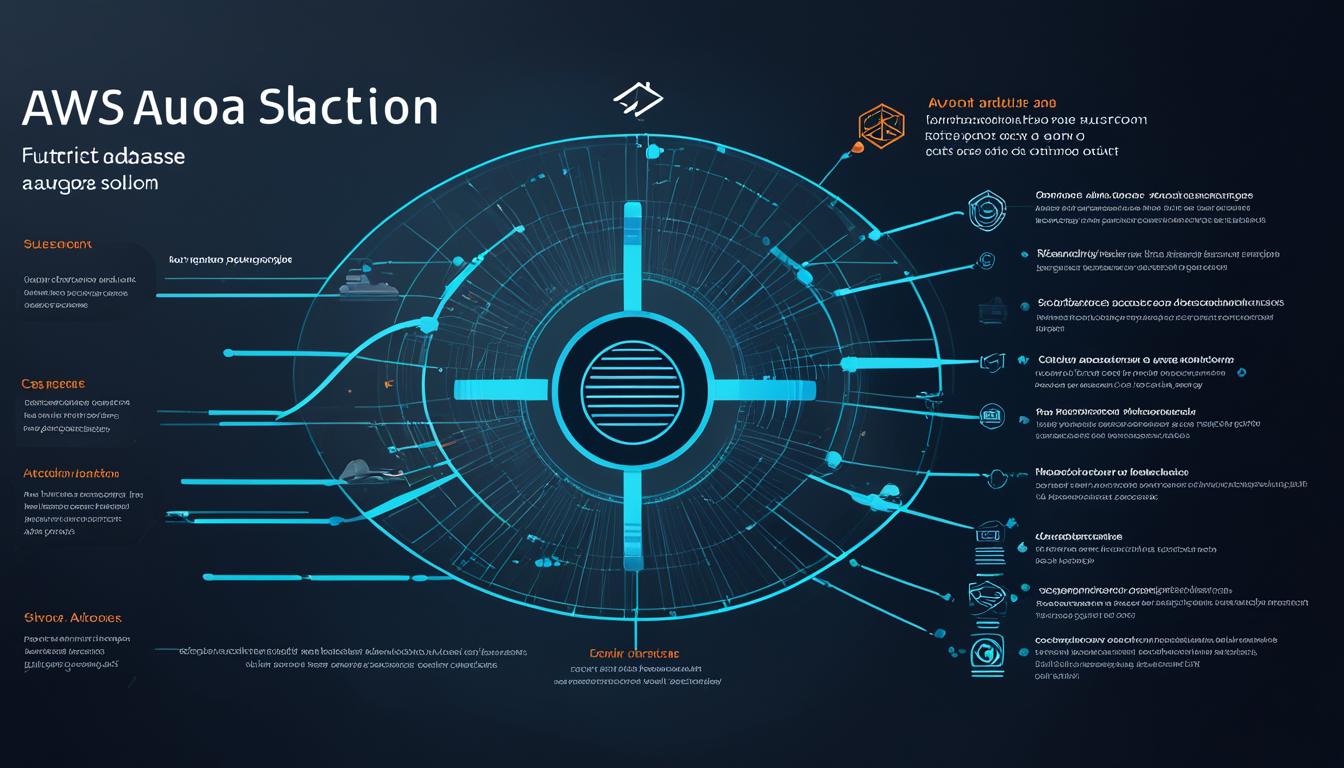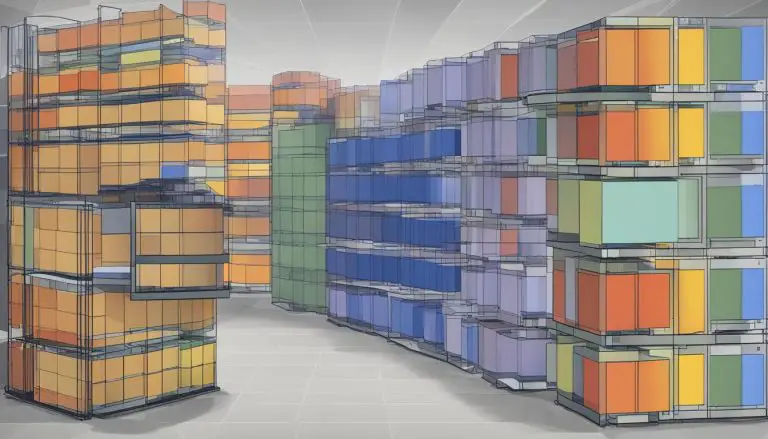What is Aurora AWS: High-Performance Database Solution
Hello readers, in this article, I will provide an in-depth exploration of Aurora AWS, a powerful database solution offered by Amazon Web Services (AWS). Whether you’re familiar with AWS or new to its services, understanding what Aurora is and its key features is essential for making informed decisions regarding your database needs.
Key Takeaways:
- Aurora AWS is a highly scalable and cost-effective database engine.
- It offers unparalleled high performance and availability.
- Aurora is compatible with MySQL and PostgreSQL.
- Key features include high performance, multi-AZ availability, and low-latency cross-Region replication.
- Amazon Aurora is suitable for various use cases, such as eCommerce applications, SaaS applications, and gaming applications.
The Benefits of Amazon Aurora
Amazon Aurora offers a wide range of benefits for users, making it a highly popular and efficient choice for database management. Its optimized architecture ensures exceptional performance even with enormous workloads, allowing businesses to handle their data efficiently and effectively.
High Scalability
“Amazon Aurora provides high scalability, offering users the freedom to easily scale their instances and storage.”
Aurora’s scalability feature allows organizations to accommodate their growing data needs without any hassle. With just a few clicks, users can adjust their instance size and storage capacity to match the requirements of their applications. This flexibility ensures that businesses can seamlessly scale their databases as their data workload increases, eliminating any limitations on growth or performance.
High Availability and Fault Tolerance
“Built-in fault tolerance and support for the Aurora global database further enhance the high availability of Amazon Aurora.”
Aurora prioritizes the availability of data, ensuring uninterrupted access for users. It incorporates fault-tolerant mechanisms that automatically handle hardware failures, making downtime a thing of the past. Additionally, it supports the Aurora global database, enabling the creation of geographically distributed database clusters for disaster recovery and workload balancing. The global replication feature ensures that data is efficiently replicated across regions, providing users with robust and reliable data protection.
Compatibility with MySQL and PostgreSQL
Amazon Aurora is widely compatible with MySQL and PostgreSQL, eliminating the need for application or tool modification.
Aurora’s compatibility with popular database engines such as MySQL and PostgreSQL allows businesses to seamlessly migrate their existing applications or tools to the Aurora environment without any modifications. This compatibility ensures a smooth transition and enables users to leverage the benefits of Aurora’s high-performance engine without disrupting their existing workflows.
Distributed and Parallel Query Processing
“Aurora’s distributed and parallel query processing significantly enhances scalability and performance.”
Aurora’s advanced query processing capabilities enable it to distribute queries across multiple nodes and process them in parallel. This parallelization of queries improves the database’s ability to handle large workloads, resulting in faster query execution and improved overall performance. By effectively utilizing the underlying resources, Aurora delivers outstanding scalability and responsiveness, even under heavy workloads.
Amazon Aurora’s exceptional benefits, ranging from scalability to compatibility and high availability, make it a top choice for businesses seeking reliable and efficient database management solutions.
Comparison Table: Aurora, RDS, and Other Database Services
| Features | Amazon Aurora | Amazon RDS | Other Database Services |
|---|---|---|---|
| Scalability | High scalability with easy instance and storage scaling | Scalable, but with additional administrative effort | Varies depending on the service |
| High Availability | Built-in fault tolerance and support for the Aurora global database | Automatic backups and Multi-AZ deployments | Varies depending on the service |
| Compatibility | Compatible with MySQL and PostgreSQL | Supports multiple database engines, including MySQL, PostgreSQL, Oracle, and more | Varies depending on the service |
| Performance | Optimized architecture for high performance | Good performance, but can vary depending on the selected instance type and configuration | Varies depending on the service |
| Pricing | Cost-effective with pay-as-you-go pricing | Varies depending on the selected database engine and instance type | Varies depending on the service |
This image illustrates the scalability of the Aurora database, showcasing its ability to handle growing workloads efficiently.
Key Features of Amazon Aurora
Amazon Aurora offers several key features that make it a standout database solution. Let’s explore these features in detail:
High Performance
Amazon Aurora provides exceptional performance, delivering up to 5 times the throughput of MySQL and 3 times the throughput of PostgreSQL. With its optimized architecture and distributed query processing, Aurora ensures that your applications can handle high workloads with ease.
Multi-AZ Availability
Aurora offers multi-AZ availability, which means it automatically replicates your database across multiple availability zones (AZs). This provides high availability and fault tolerance, ensuring your data is always accessible and protected against infrastructure failures.
Distributed Storage for Durability and Fast Recovery
To ensure durability and fast recovery, Amazon Aurora stores data across multiple storage nodes in a distributed manner. This distributed storage architecture enhances data reliability, while also enabling quick recovery in the event of a failure.
Flexible and Auto-Scaling Compute
Aurora allows you to easily scale your compute resources based on the needs of your applications. You can automatically add or remove compute capacity to ensure optimal performance and cost-efficiency.
Low-Latency Cross-Region Replication
With low-latency cross-Region replication, Amazon Aurora enables you to replicate your data to different AWS Regions, providing geographical redundancy and disaster recovery capabilities. This ensures that your applications remain available even in the face of regional outages.
Aurora’s key features make it a top choice for high-performance database solutions. It combines speed, availability, durability, and scalability to support even the most demanding workloads.
| Key Features | Description |
|---|---|
| High Performance | Delivers up to 5x the throughput of MySQL and 3x the throughput of PostgreSQL |
| Multi-AZ Availability | Provides automatic replication across multiple availability zones for high availability |
| Distributed Storage | Stores data across multiple storage nodes for durability and fast recovery |
| Flexible and Auto-Scaling Compute | Allows easy scaling of compute resources for optimal performance and cost-efficiency |
| Low-Latency Cross-Region Replication | Enables replication of data to different AWS Regions for geographical redundancy and disaster recovery |
How Amazon Aurora Works
Amazon Aurora is a powerful and intuitive database engine that simplifies the migration process from MySQL or PostgreSQL databases using standard tools. With Aurora, you can effortlessly transfer your data and applications, ensuring a seamless transition without any disruptions. This ease of migration enables you to quickly take advantage of the performance and scalability benefits offered by Aurora.
In addition to its migration capabilities, Amazon Aurora supports running legacy SQL Server applications with Babelfish for Aurora PostgreSQL. The compatibility and minimal code changes required make it a convenient choice for organizations with existing SQL Server applications looking to harness the power of Aurora.
One of the standout features of Amazon Aurora is its built-in security measures, continuous backups, and serverless compute. This means that you can focus on developing and deploying your applications without worrying about the security and reliability of your database. Aurora takes care of these aspects for you, providing peace of mind and allowing you to concentrate on what you do best.
Furthermore, Amazon Aurora offers up to 15 read replicas, enabling improved scalability and performance for your applications. These replicas allow you to distribute read traffic efficiently, resulting in faster response times and an enhanced user experience.
Automated multi-Region replication is another critical feature of Amazon Aurora. This functionality enables quick disaster recovery by replicating your data across multiple AWS Regions. In the event of an outage or data loss, you can quickly and seamlessly failover to a replica instance in another Region, ensuring minimal disruption to your business operations.
Integrations with other AWS services make Amazon Aurora a highly versatile and powerful database solution. By leveraging the analytical capabilities of services like AWS Glue and Amazon Redshift, you can extract valuable insights from your data, monitor trends, and make data-driven decisions. Additionally, integrating with services like AWS Identity and Access Management (IAM) and AWS CloudTrail enhances the security of your Aurora database, protecting your valuable information from unauthorized access.
To summarize, Amazon Aurora simplifies the migration process, offers robust security and backup features, provides scalability through read replicas, and supports multi-Region replication for disaster recovery. Its seamless integration with other AWS services allows you to leverage the full potential of your data. Whether you’re a small business or a large enterprise, Amazon Aurora is a reliable and efficient database solution that meets the needs of today’s demanding applications.
Comparing Amazon Aurora with Other Database Services
When it comes to database services, Amazon Aurora stands out with its superior performance and scalability compared to traditional RDBMS systems and other cloud-based database services. Aurora combines optimized storage and advanced query execution to deliver exceptional performance, making it an ideal choice for high-performance applications and critical workloads.
One of the key advantages of Amazon Aurora is its scalability. With automatic scaling options, Aurora can easily handle growing workloads and adapt to changing demands. This scalability ensures that your database can keep up with the evolving needs of your application without any performance bottlenecks.
Another significant advantage of Aurora is its cost-effectiveness. It offers a compelling alternative to standard RDBMS solutions by providing strong performance at a lower cost. Aurora strikes a balance between delivering high performance and affordability, making it an attractive option for businesses looking to optimize their database expenses.
However, if your application requires a specific database engine that is not supported by Aurora, Amazon RDS may be a more flexible choice. RDS allows you to select from a wide range of database engines, including MySQL, PostgreSQL, Oracle, and SQL Server, providing you with the freedom to use the engine that best fits your application requirements.
“Amazon Aurora offers better scalability, affordability, and performance compared to traditional RDBMS systems. However, if your application demands a specific database engine that Aurora doesn’t support, Amazon RDS provides the flexibility you need.”
To summarize, Amazon Aurora shines in terms of performance, scalability, and cost-effectiveness. It outperforms traditional RDBMS systems and offers an excellent balance of performance and affordability. However, if your application requires a specific database engine not supported by Aurora, Amazon RDS provides the flexibility to meet your needs.
| Feature | Amazon Aurora | Amazon RDS |
|---|---|---|
| Performance | Superior | Depends on the chosen database engine |
| Scalability | Excellent | Good |
| Cost | Affordable | Affordable, but depends on the chosen database engine |
| Database Engine Support | MySQL and PostgreSQL | MySQL, PostgreSQL, Oracle, SQL Server, and more |
Amazon Aurora vs. Amazon RDS: Feature Comparison
Here’s a detailed comparison of key features between Amazon Aurora and Amazon RDS:
- Performance: Amazon Aurora offers superior performance compared to Amazon RDS, especially for intensive workloads. Aurora’s optimized storage and query execution contribute to its exceptional performance.
- Scalability: Both Amazon Aurora and Amazon RDS provide good scalability. Aurora’s automatic scaling options allow it to handle growing workloads efficiently. RDS offers scalability based on the chosen database engine.
- Cost: Amazon Aurora is more cost-effective than traditional RDBMS systems. It provides strong performance at a lower cost. Amazon RDS’s cost depends on the chosen database engine.
- Database Engine Support: Amazon Aurora supports MySQL and PostgreSQL. Amazon RDS offers support for a wide range of database engines, including MySQL, PostgreSQL, Oracle, SQL Server, and more.

By considering these factors, you can make an informed decision about whether Amazon Aurora or Amazon RDS is the right choice for your application.
Use Cases for Amazon Aurora and RDS
When it comes to choosing the right database service for your applications, Amazon Aurora and RDS offer a range of use cases to meet your specific needs. Whether you’re running an eCommerce platform, a SaaS application, or a gaming application, both Aurora and RDS have features to support your requirements.
Amazon Aurora
Amazon Aurora is an excellent choice for high-performance, scalable applications with low latency demands. Here are some specific use cases where Aurora shines:
- eCommerce Applications: Aurora’s high-throughput and low-latency capabilities make it perfect for handling the large volumes of transactions common in online retail.
- SaaS Applications: Aurora’s multi-tenant workload handling and automated scaling features align well with the dynamic scaling needs of software-as-a-service providers.
- Gaming Applications: Real-time gaming applications benefit from Aurora’s exceptional throughput and low latency, ensuring smooth gameplay experiences for users.
To illustrate the performance benefits of Amazon Aurora, consider the following table that compares Aurora’s capabilities to traditional databases:
| Database | Throughput Comparison | Latency Comparison |
|---|---|---|
| Amazon Aurora | 5x the throughput of MySQL 3x the throughput of PostgreSQL |
Low latency for optimal real-time applications |
| Traditional Databases | Lower throughput compared to Aurora | Higher latency compared to Aurora |
Amazon RDS
Amazon RDS offers a simple, scalable, and cost-effective database solution for a wide range of applications. Here are some popular use cases for Amazon RDS:
- Web Applications: RDS provides a reliable and scalable database option for web applications of all sizes, ensuring efficient data management.
- E-commerce Platforms: With strong availability and durability, RDS is an ideal choice for powering online shopping platforms with high transaction volumes.
- Content Management Systems: RDS supports content management systems, enabling efficient storage and retrieval of large amounts of structured data.
- Mobile App Backends: RDS offers a robust and scalable backend solution for mobile applications, ensuring seamless data synchronization across devices.
- Data Analytics Apps: RDS provides the necessary infrastructure to support data analytics applications, helping you derive valuable insights from your data.
To better understand the benefits of Amazon RDS, here is a comparison table between RDS and traditional databases:
| Database | Scalability | Availability | Affordability |
|---|---|---|---|
| Amazon RDS | Offers simple and scalable database solutions | Strong availability and durability | Affordable pricing options |
| Traditional Databases | May require additional manual scaling | May have lower availability compared to RDS | Costs may be higher compared to RDS |
By understanding these use cases and comparing the capabilities of Amazon Aurora and RDS, you can make an informed decision to align your database requirements with the right AWS service.
Conclusion
In conclusion, Amazon Aurora and RDS are both powerful database solutions offered by AWS. Aurora is a highly scalable, high-performance database engine that provides cost-effective options for performance-intensive applications. It offers several benefits such as high availability, durability, and compatibility with MySQL and PostgreSQL. Aurora is suitable for various use cases including eCommerce, SaaS, and gaming applications.
On the other hand, RDS is a managed database service that simplifies database administration and offers scalability, availability, and affordability. It is recommended for small to large-scale applications with predictable growth and budget constraints.
The choice between Aurora and RDS depends on the specific requirements of your application, workload characteristics, budget constraints, and technical expertise. Consider factors such as performance needs, scalability requirements, and budget limitations when making a decision. Both Aurora and RDS are reliable database solutions with their own unique advantages, so it’s important to evaluate your specific needs before making a choice.
FAQ
What is Amazon Aurora?
Amazon Aurora is a highly scalable, cost-effective database engine offered by Amazon Web Services (AWS). It leverages the capabilities of AWS and provides high-performance, high-availability database solutions.
What are the benefits of using Amazon Aurora?
Amazon Aurora offers several benefits, including scalability, compatibility with MySQL and PostgreSQL, high performance, and low-latency cross-region replication. It also provides built-in security, continuous backups, serverless compute, and integrations with other AWS services.
What are the key features of Amazon Aurora?
The key features of Amazon Aurora include high performance, multi-AZ availability, distributed storage for durability, auto-scaling compute, and low-latency cross-region replication. It also supports low-latency read replicas and provides up to 15 read replicas for improved scalability and performance.
How does Amazon Aurora compare to other database services?
Amazon Aurora outperforms traditional RDBMS systems in terms of performance and scalability. It is also more cost-effective compared to other database solutions. However, other services like Amazon RDS may be more flexible in terms of supporting various database engines.
What are the use cases for Amazon Aurora and Amazon RDS?
Amazon Aurora is recommended for eCommerce applications, SaaS applications, and gaming applications that require high performance and scalability. On the other hand, Amazon RDS is suitable for small to large-scale applications, including web applications, e-commerce platforms, content management systems, mobile app backends, and data analytics apps.
How easy is it to migrate to Amazon Aurora?
Amazon Aurora supports easy migration from MySQL or PostgreSQL databases using standard tools. It also supports running legacy SQL Server applications with minimal code changes using Babelfish for Aurora PostgreSQL.
Can I use Aurora read replicas to improve scalability and performance?
Yes, Amazon Aurora supports up to 15 read replicas for improved scalability and performance. These read replicas allow you to increase read throughput and reduce replica lag time.
Source Links
- About the Author
- Latest Posts
Mark is a senior content editor at Text-Center.com and has more than 20 years of experience with linux and windows operating systems. He also writes for Biteno.com






